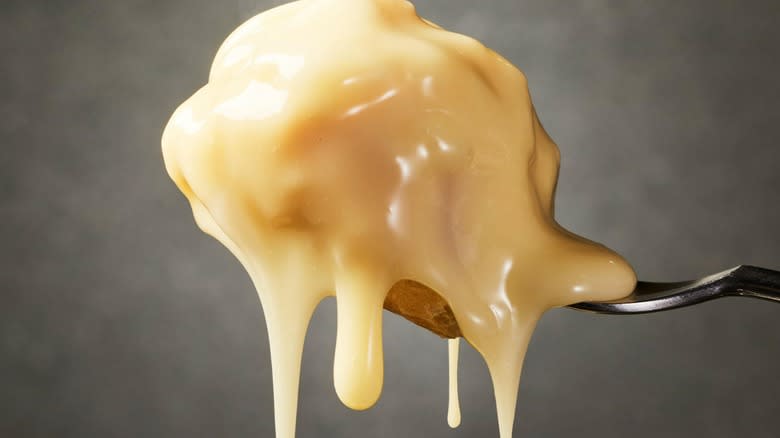You Can Thank A Swiss Cartel For Fondue's Once-Massive Popularity

"Fondue rocks," diehard fans might eagerly declare. "I don't need any help or encouragement to like it." True, fondue's deliciousness and novelty have perpetuated its enduring popularity. But the fact that the melted cheese treat initially cropped up on foodies' radars at all was the result of carefully orchestrated cartel activity (yes, really). Cheese fondue formally made its global debut at the 1964 World's Fair in New York and the rest is (literally) history.
But, if it wasn't for the Swiss cheese cartel, chances are that foodies outside of Switzerland wouldn't even "do the fondue" at all. The cheese cartels' aggressive marketing campaign for fondue in the 1970s is what created its reputation as the lifeblood of Alpine skiers, New England winters, and chalets everywhere. This period also coincided with the renaissance of at-home dinner parties in fashionable U.K. and American households, which made fondue the perfect centerpiece. It all started after World War I when Switzerland found itself with a surplus of cheese.
While much of Europe was left in ruins, Swiss cows were happily grazing away and lactating like mad. To prevent any one cheesemonger from seizing too much of the market share, a sort of round table conference was held between Switzerland's leading cheese makers in which they agreed not to compete with one another. Sounds pretty diplomatic, right? The part where they agreed not to compete is what made the union a cartel, which, per Merriam-Webster, is "a combination of independent commercial or industrial enterprises designed to limit competition or fix prices."
Read more: 25 Most Popular Snacks In America Ranked Worst To Best
A Cheese-Flavored Taste Of Power (Pun Intended)

For nearly a century, the bulk of Switzerland's economy was controlled by an association of Swiss cheese makers, aka Schweizer Kaseunion. This unofficial union determined the price, production, and types of cheese made in Switzerland for decades. Small-time cheesemongers had to receive permission from the Union before they could sell their cheeses -- which led to a secret cheese black market that operated entirely under the table. The Swiss Cheese Union was over by the 1990s, but its influence endures.
It was during the late 1800s that fondue first cemented itself as a treat for the upper crust when it found a steadfast fanbase with foodies in the Rhône-Alpes region near the French-speaking Swiss-Geneva border. But it was the Union's influence that popularized holey Emmental and solidified its reputation as the emblematic "Swiss cheese" with which the country is largely synonymous today. The Union even declared fondue as the official national dish of Switzerland in 1930.
Of course, the estimated 20,000 Swiss-speaking immigrants who relocated to Wisconsin during the 1800s also brought fondue with them (cheese lovers, rise up). With all this in mind, it seems like less of a happy accident (maybe not an accident at all) that the best part of fondue to many fans is the sum of solidified cheese waiting at the bottom of the pot -- a siren calling foodies to finish the entire bowl and collect their decadent prize.
Read the original article on Tasting Table.


